Work samples
-
Apunte Betico by Gerardo GombauApunte Betico by Gerardo Gombau (1906-1971) is a piece that won the Northern California Harpists' Association Award in 1952. This award was designed to encourage new works written for the harp, and the president of the association, Yvonne LaMothe Schwager edited this work. In this dramatic Spanish piece, Gombau utilizes the full range of the harp beautifully.
-
Fantaisie sur un theme de Haydn, op. 31 by Marcel GrandjanyFantaisie sur un theme de Haydn, op. 31 by Marcel Grandjany opens with a dramatic introduction, followed by a simple rendition of the theme before moving into five variations on the theme. Each variation shows the harp and it's many capabilities in a different way throughout this virtuosic work.
-
Sonata for Harp by Paul HindemithPaul Hindemith (1895-1963) wrote his Sonata for Harp in 1939. Written in three movements (I. Mässig schnell II. Lebhaft III. Sehr langsam), it demonstrates a masterful understanding of the harp. It remains a staple of the harp repertoire and an excellent example of 20th century writing for the harp.
-
Premiere Arabesque by Claude Debussy, trans. Henriette ReniéThe Premiere Arabesque by Claude Debussy (1862-1918) is a well-known work by Debussy. Originally written for solo piano, it is here transcribed for Henriette Renié, who made few changes to the original, but did change the key from E Major to E-flat Major.
About Jacqueline
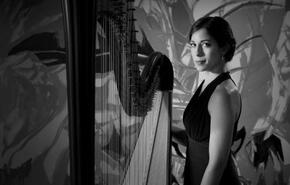
Jacqueline Pollauf, American harpist, is known for her sensitive performances, dedication to teaching, and beautifully-crafted compositions. Past performances include a premiere for voice and harp at Carnegie Hall, as well as appearances at the Eleventh World Harp Congress and the National Gallery of Art in Washington D. C. Her most recent recording, Beau Soir, with cellist Dariusz Skoraczewski, was lauded as “utter perfection” (The Harp Column).
Jacqueline… more
Jacqueline… more
Jump to a project:
Twentieth Century Music
Many twentieth century composers use the harp in unusual or surprising ways, seeking to push the instrument to its limits. I've always enjoyed the challenge of interpreting twenthieth century music.
-
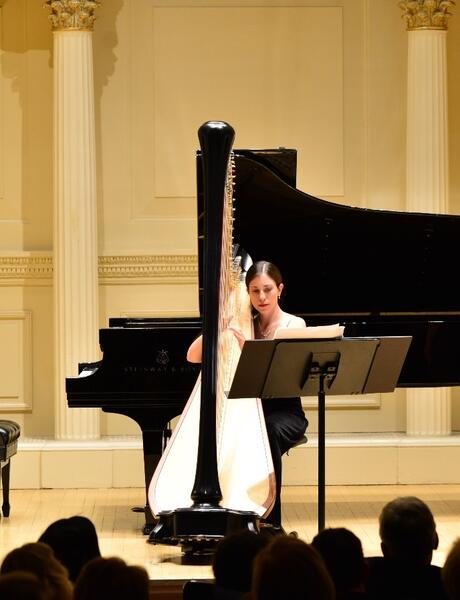 Performance at Carnegie HallPerformance at Carnegie Hall, New York, New York.
Performance at Carnegie HallPerformance at Carnegie Hall, New York, New York. -
Dance of the Bull by R. Murray SchaferThe Dance of the Bull comes from Canadian composer R. Murray Schafer's (b. 1933) larger suite, the Crown of Ariadne, based on the Greek myth of Thesus, Ariadne and the minotaur. The Dance of the Bull is an aggressive piece depicting the minatour full of fury, with brief moments when the light and airy gestures of Adriadne break through. Many percussive extended techniques are employed, including the xylophone effect, the thunder gliss, the extensive use of pedal slides, and scraping the strings with a coin.
-
Sonata for Harp by Paul HindemithPaul Hindemith (1895-1963) wrote his Sonata for Harp in 1939. Written in three movements (I. Mässig schnell II. Lebhaft III. Sehr langsam), it demonstrates a masterful understanding of the harp. It remains a staple of the harp repertoire and an excellent example of 20th century writing for the harp.
-
Glitch by Robert PatersonGlitch by Robert Paterson (b. 1970) is a contemporary piece for solo harp performed here by Jacqueline Pollauf. Here is the program note from the composer: "A ‘glitch’ may be defined as a sudden, usually temporary equipment malfunction or irregularity, and it also means to suffer from such a malfunction or irregularity. In Glitch, my primary goal was to create a fun, highly rhythmic piece with lots of twists and turns, using a few extended techniques to emulate glitches in the musical tapestry. Each glitch interrupts the current section a couple times, triggering the next section."
-
Interlude from A Ceremony of Carols by Benjamin BrittenBenjamin Britten (1913-1976) wrote A Ceremony of Carols for treble voices and harp in 1948. The work consists of many short pieces, and this interlude for solo harp comes at the center of the piece and echoes the a capella processional and recessional. Britten uses harmonics extensively throughout the piece, which gives it a sense of stillness.
-
Prayer by Sergiu NatraSergiu Natra (b. 1924) is a Romanian-born composer who has resided in Israel for many years. He feels a strong affinity to the harp and has written an extensive amount of solo and chamber music for the harp. Prayer, from 1970, has been a required piece for several international harp competitions and remains popular among the harp community. It features Natra's signature style involving repeated motifs, alternating rhythmic and free sections, dissonant harmonies, and a wide variety of articulations.
-
In a Landscape by John CageIn a Landscape by John Cage (1912-1992) was written in 1948. He wrote the piece to be played on either solo piano or solo harp. It's a surprising piece as it's not nearly as experimental or avant-garde as one would expect from Cage. Instead, it bears a marked resemblance to Erik Satie's (1866-1925) music, and seems to suspend time.
-
Apunte Betico by Gerardo GombauApunte Betico by Gerardo Gombau (1906-1971) is a piece that won the Northern California Harpists' Association Award in 1952. This award was designed to encourage new works written for the harp, and the president of the association, Yvonne LaMothe Schwager edited this work.
-
Petite Suite by David WatkinsThe Petite Suite is a set of three pieces written by harpist-composer David Watkins (b. 1938). In addition to using the harp in innovative ways, many layers of rhythmic patterns are explored throughout the pieces. I. Prelude 0:08 II. Nocturne 4:10 III. Fire Dance 7:06
-
Impromptu, op. 48 by Lex van DeldenImpromptu, op. 48 was written by Dutch composer by Lex van Delden (1919-1988) in 1955. This dark and dramatic piece won the Northern California Harpists' Association Award, a composition competition that encouraged composers to write for the harp.
Impressionist Composers
The harp is an instrument exquisitely-suited to impressionistic composers with its resonance and many colors and nuances. In this section, you'll find pieces by both famous and little-known impressionist composers.
-
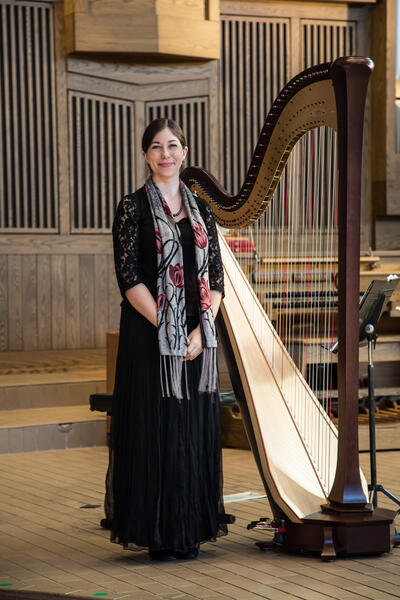 Performance in Columbia, MarylandJacqueline acknowledges applause after a performance in Columbia, Maryland.
Performance in Columbia, MarylandJacqueline acknowledges applause after a performance in Columbia, Maryland. -
Premiere Arabesque by Claude Debussy, trans. Henriette ReniéThe Premiere Arabesque by Claude Debussy (1862-1918) is a well-known work by Debussy. Originally written for solo piano, it is here transcribed for Henriette Renié, who made few changes to the original, but did change the key from E Major to E-flat Major.
-
Prélude in a minor by Maurice Ravel, trans. Carlos SalzedoThis short prelude was written by Maurice Ravel (1875-1937) for the piano, as a sight-reading exam for pianists at the Paris Conservatoire. It was transcribed for the harp by harpist and composer Carlos Salzedo (1885-1961). As with many works by Ravel, the chromaticism makes it challenging to play on the harp.
-
Gymnopédie no. 1 by Erik Satie, transcribed by Jacqueline PollaufGymnopédie no. 1 by Erik Satie (1866-1925) is a famous piece, with a haunting melody. Although originally written for the piano, it suits the harp quite well and very few changes have been in this transcription.
-
La fille aux cheveaux de lin by Claude Debussy, trans. Marcel GrandjanyLa Fille aux Cheveux de Lin (The Girl with the Flaxen Hair) by Claude Debussy (1862-1918) was originally written for solo piano, and has here been transcribed for harp by Marcel Grandjany (1891-1975). As with several of Debussy's solo piano works, harpists immediately saw possibilities for the harp and rushed to transcribe them.
-
Lotus Land by Cyril Scott, trans. Jacqueline PollaufLotus Land, by British composer Cyril Scott (1879-1970), is perhaps the best-known piece of Scott's more than four hundred works. Lotus Land was originally written for the piano, and I first encountered both the piece and the composer through my study of the piano. A few years ago I transcribed it for the harp, and much of the piece is beautifully suited for the instrument. The original score features two pentatonic glissandi which are completely idiomatic to the harp.
-
Deux Pieces by Jeanne Adrienne Kufferath (1874-1919)Deux Pièces (Two Pieces) by Jeanne Adrienne Kufferath (1874-1919) is a set of two short pieces, Simple Histoire (A Simple Story) and Autrefois (In Olden Days). Kufferath is a virtually unknown Belgian harpist and composer. I stumbled upon her when researching Tiny Bèon, whose transcription of Passacaglia from Suite no. 7 by George Handel is dedicated to Kufferath. Kufferath's entire compositional output is these two charming pieces, which bear a resemblance to Henriette's Renié's works, particularly her Feuillets d'Album.
-
Fontainebleau Suite: Palace Lake by Grace Becker Vamos, played by Jacqueline PollaufPalace Lake is the first piece from the Fontainebleau Suite by Grace Becker Vamos (1898-1992). This little-known piece was written by American cellist and composer Grace Vamos and was most likely inspired by the time she spent studying at the Fontainebleau School of Music in France. Vamos performed in a flute, harp and cello trio and arranged much of the music for the group, which gave her a strong sense of the harp and its capabilites when composing for the instrument.
-
Fontainebleau Suite: Summer Night by Grace Becker Vamos, played by Jacqueline PollaufSummer Night is the second piece from the Fontainebleau Suite by Grace Becker Vamos (1898-1992). Although the entire work is most likely inspired by the time Vamos spent studying in France, this movement has more of an American blues feel to it.
-
Fontainebleau Suite: Forest by Grace Becker Vamos, played by Jacqueline PollaufForest is the third piece from the Fontainebleau Suite by Grace Becker Vamos (1898-1992). Here Vamos emulates a style of composition similar to that of Marcel Tournier (1879-1951), writing a melody intertwined with the quick moving notes of the accompaniment.
The Music of Marcel Grandjany
French harpist Marcel Grandjany (1891-1975) expanded the harp repertoire greatly in his life time, both through original works and transcriptions. This section showcases his work and his ability to put the harp in its best light in all of his work. I have always been drawn to his music, especially as he was the teacher of my teacher, Ruth K. Inglefield.
-
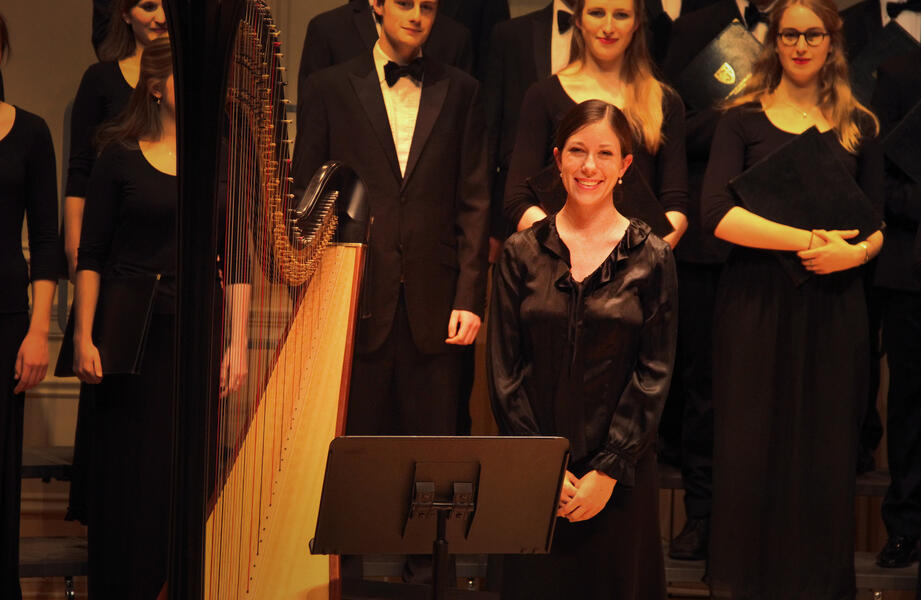 Performance at the Library of CongressPerformance at the Library of Congress, Washington D. C.
Performance at the Library of CongressPerformance at the Library of Congress, Washington D. C. -
Fantaisie sur un theme de Haydn, op. 31 by Marcel GrandjanyFantaisie sur un theme de Haydn, op. 31 by Marcel Grandjany opens with a dramatic introduction, followed by a simple rendition of the theme before moving into five variations on the theme. Each variation shows the harp and it's many capabilities in a different way throughout this virtuosic work.
-
Aria in Classic Style by Marcel GrandjanyJason Kissel, organ; Jacqueline Pollauf, harp. Aria in Classic Style by Marcel Grandjany (1891-1975) is a beautiful piece for harp and organ. Grandjany was primarily a harpist, but also played some organ, which shows in his writing here. Grandjany blends the two instruments beautifully, so at times it is impossible to tell which instrument is which.
-
El Viejo Castillo Moro by Eduardo Chavarri, trans. Marcel GrandjanyEl Viejo Castillo Moro by Eduardo Lopez-Chavarri (1971-1970) was originally written for piano. Marcel Grandjany (1891-1975) transcribed this beautiful short piece for the harp using many idiomatic harp techniques.
-
Pavane et Bransles by Antoine Francisque, transcribed by Marcel GrandjanyPavane et Bransles by Antoine Francisque (c.1570-1605) comes from Francisque's larger work, Le Trésor d'Orphée, and was originally written for the lute. It was then transcribed for the harp by Marcel Grandjany. In the stately Pavane, Grandjany uses the lowest registers of the harp extensively. Throughout the more lively Bransles, the cheerful melody is frequently paired with a rhythmic, almost percussive, accompaniment.
-
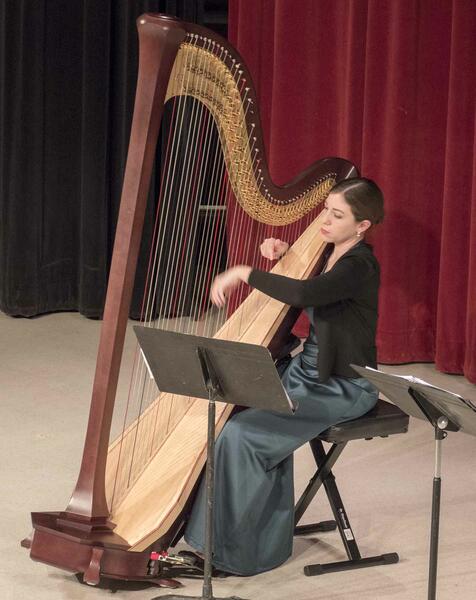 Performance at Goucher CollegePerformance at Goucher College, Baltimore, Maryland. Photo by Lawrence Sigel.
Performance at Goucher CollegePerformance at Goucher College, Baltimore, Maryland. Photo by Lawrence Sigel. -
Clair de Lune by Claude Debussy, transcribed by Marcel GrandjanyClair de Lune by Claude Debussy (1862-1918) was originally written for piano and here has been transcribed for the harp by Marcel Grandjany (1891-1975). As with many other pieces from the impressionist era, the work is beautifully suited to the harp.
-
Sarabande and Double from Violin Partita no. 1, BWV 1002 by J. S. Bach, trans. Marcel GrandjanySarabande and Sarabande's Double from Violin Partita no. 1, BWV 1002 by J. S. Bach (1685-1750) was originally written for solo violin. Marcel Grandjany (1891-1975) transcribed it for harp, filling out many of the implied harmonies in a lush arrangement.
-
Sacro Monte by Joaquin Turina, trans. Marcel GrandjanyMarcel Grandjany's (1891-1975) transcription of Sacro Monte, by Joaquín Turina (1882-1949), shows his admirable abilities in transcribing, especially in the climax of the piece. Unfortunately Grandjany never published this particular transcription, so I have recreated it, using Grandjany's own recording of the piece as a reference.
-
Andante from Violin Sonata no. 2 by J. S. Bach, transcribed Marcel GrandjanyAndante from Violin Sonata no. 2, BWV 1003, by J. S. Bach (1685-1750) was written for solo violin, and then transcribed for harp by Marcel Grandjany (1891-1975). In his transcription Grandjany filled out the piece, expanding Bach's sparse writing into full chords and adding a more definitive harmony.
Beau Soir Album
Cellist Dariusz Skoraczewski and I released an album of harp and cello music in 2019, called Beau Soir (Beautiful Evening) after the title track. Although it's a beautiful combination of instruments, there isn't much written for harp and cello, so we've transcribed and arranged almost all of the works ourselves. In this section you'll find a few highlights from the album.
-
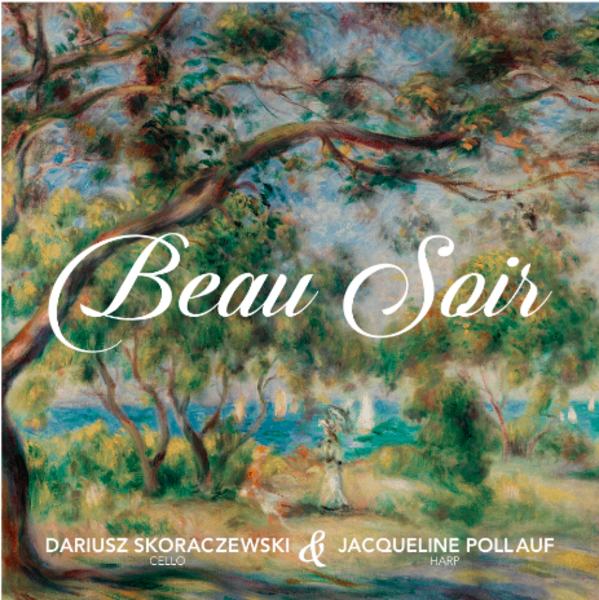 Beau Soir CD CoverCD Cover for Beau Soir, 2019 album of cello and harp music by Dariusz Skoraczewski and Jacqueline Pollauf.
Beau Soir CD CoverCD Cover for Beau Soir, 2019 album of cello and harp music by Dariusz Skoraczewski and Jacqueline Pollauf. -
Beau Soir by Claude DebussyDariusz Skoraczewski, cello, and Jacqueline Pollauf, harp, perform Beau Soir (Beautiful Evening), by Claude Debussy (1862-1918). Beau Soir was originally written for voice and piano, setting a text by Paul Borget: Lorsque au soleil couchant les rivières sont roses, Et qu'un tiède frisson court sur les champs de blé, Un conseil d'être heureux semble sortir des choses Et monter vers le cœur troublé ; Un conseil de goûter le charme d'être au monde, Cependant qu'on est jeune et que le soir est beau, Car nous nous en allons comme s'en va cette onde : Elle à la mer, -- nous au tombeau ! When rivers are pink in the setting sun, And a slight shiver runs through fields of wheat, A suggestion to be happy seems to rise up from things And ascends toward the troubled heart; A suggestion to taste the charms of the world While one is young and the evening is fair, For we are on our way just as this wave is: It is going to the sea, -- and we, to the grave!
-
Clair de Lune by Claude DebussyDariusz Skoraczewski, cello, and Jacqueline Pollauf, harp, perform Clair de Lune. Written by Claude Debussy (1862-1918) for solo piano originally, and many transcriptions exit. In this transcription the melody soars in the cello while the harp provides lush arpeggios and harmonies in support.
-
The Swan by Camille Saint-SaënsDariusz Skoraczewski, cello and Jacqueline Pollauf, harp, perform Camille Saint-Saëns' (1835-1921) The Swan. Saint-Saëns wrote The Swan as part of his larger work, the Carnival of Animals. This is a classic work for harp and cello, giving both musicians room to explore the idiomatic qualities of their instruments.
-
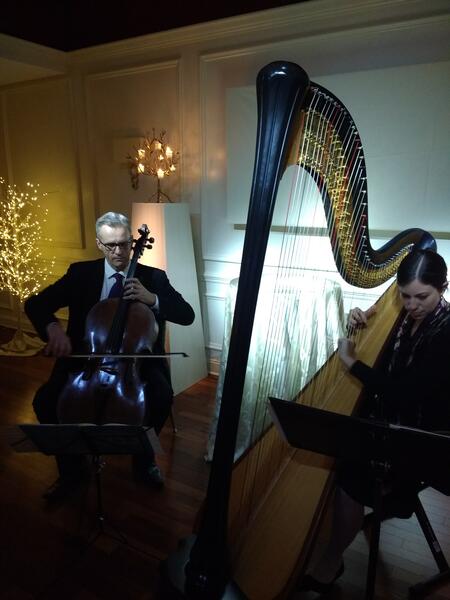 Performance by Dariusz Skoraczewski and Jacqueline PollaufDariusz Skoraczewski and Jacqueline Pollauf perform on cello and harp.
Performance by Dariusz Skoraczewski and Jacqueline PollaufDariusz Skoraczewski and Jacqueline Pollauf perform on cello and harp. -
Six Studies in English Folk Song by Ralph Vaughn WilliamsDariusz Skoraczewski, cello, and Jacqueline Pollauf, harp, perform Six Studies in English Folk Song, originally written by Ralph Vaughn Williams (1872-1958) for cello and piano. Here it has been transcribed by Jacqueline Pollauf for cello and harp. It's a set of six short pieces, each with a slightly different feel. I. Adagio (Lovely on the Water) II. Adagio sostenuto (Spurn Point) III. Larghetto (Van Dieman's Land) IV. Lento (She Borrowed Some of her Mother's Gold) V. Andante tranquillo (The Lady and the Dragoon) VI. Allegro vivace (As I Walked Over London Bridge)
-
Romance en La Majeur, Op. 69 by Gabriel Fauré, arr. Jacqueline PollaufDariusz Skoraczewski, cello; and Jacqueline Pollauf, harp. Romance, Op. 69 by Gabriel Fauré (1845-1924) was originally written for cello and organ, but before it was premiered and published, Fauré reworked the piece for cello and piano. In this transcription for cello and harp, the resonance of the harp creates a beautiful backdrop for the piece while the cello shines.
-
Fratres by Arvo PärtDariusz Skoraczewski, cello; and Jacqueline Pollauf, harp. Fratres was written by Estonian composer Arvo Pärt (b. 1935) in 1977. Pärt is considered a minimalist composer, and the entire piece is based on just a few bars of material. The piece exists in versions for many different combination of instruments. This version is most similar to the version for cello and piano. The lowest string of the harp is tuned a third lower than usual to approximate the range of the piano.
-
Après un rêve by Gabriel Fauré, trans. Jacqueline PollaufDariusz Skoraczewski, cello; and Jacqueline Pollauf, harp. Après un rêve (After a Dream), from Trois Mélodies, op. 7 by Gabriel Fauré was originally written for voice and piano. In this transcription, the melody soars in the cello with the harp providing a mesmerizing chordal harmony.
-
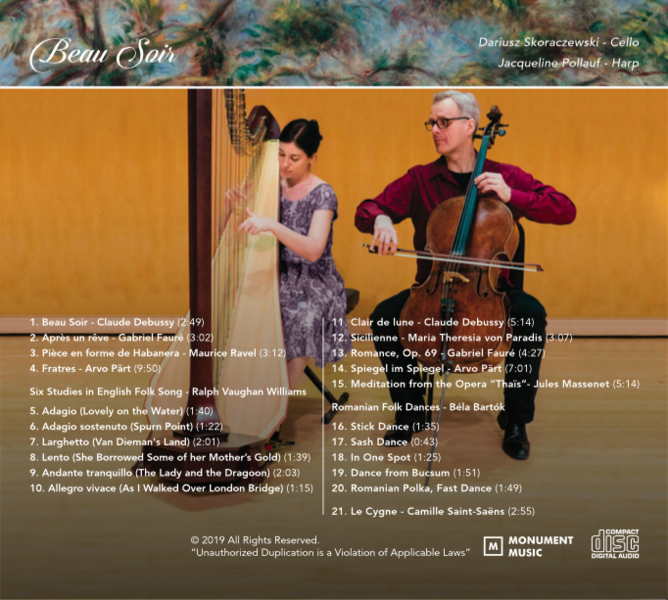 Back cover of Beau SoirThe back cover of the 2019 album Beau Soir.
Back cover of Beau SoirThe back cover of the 2019 album Beau Soir.
Harpist Composers
Many harpists end up composing for the harp themselves, and do so quite well as they understand the capabilities of the instrument, the resonance of different registers, and how best to write idiomatically for the harp. Not only do such compositions expand the repertoire of the harp, but they are also highly rewarding to play.
-
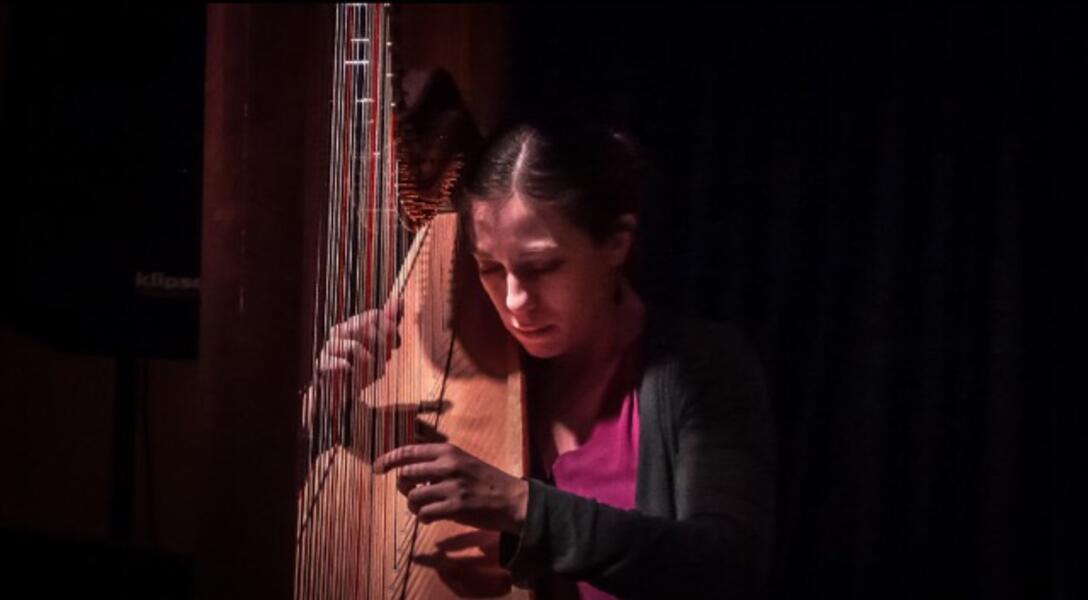 Performance in Baltimore, MarylandJacqueline performs in Baltimore, Maryland.
Performance in Baltimore, MarylandJacqueline performs in Baltimore, Maryland. -
The Minstrel's Adieu to His Native Land by John ThomasJohn Thomas (1826-1913) was a Welsh harpist and composer. The Minstrel's Adieu to His Native Land is one of his best-known works, a classic theme and variations, and it showcases many dramatic effects on the harp.
-
Lolita la Danseuse by Marcel TournierLolita la Danseuse (Lolita, the Dancer) by Marcel Tournier (1879-1951) is a short and dramatic piece, taken from Tournier's Images, Suite no. 1. The title of this evocative piece captures its essence perfectly.
-
Berceuse Russe by Marcel TournierBerceuse Russe (Russian Lullaby), op. 40 by Marcel Tournier (1879-1951) is a beautiful example of Tournier's exquisite writing for the harp. Himself a French harpist, Tournier explores the many subtleties and delicate nuances of the instrument in this lullaby.
-
Petite Valse, op. 25 by Alphonse HasselmansPetite Valse, op. 25 by Alphonse Hasselmans (1845-1912) is one of the composer's lesser-known works. Hasselmans was himself a harpist and taught at the Paris Conservatoire for many years. This dramatic waltz in c minor is a beautiful example of his excellent understanding of the harp and its capabilities.
-
Pistache by Bernard AndrèsPistache (Pistachio) by French harpist and composer Bernard Andrès (b. 1941) is a dramatic piece featuring many extended techniques on the harp. It's from a larger suite of pieces, called Èpices. It alternates between free and rhythmic sections.
-
The Mermaid's Chimes by Carlos SalzedoThe Mermaid's Chimes (Carillon sous-marin) by Carlos Salzedo (1885-1961) is a short character sketch from his book Short Stories in Music, Book 2. Filled with harmonics, it creates an underwater sound world.
-
Au Monastère by Alphonse HasselmansAlphonse Hasselmans (1845-1912) was a Belgian-born harpist, teacher and composer who spent most of his life living and working in France. Perhaps best remembered for the many major 20th century harpists he trained, he also composed quite a few works for solo harp. Au Monastère (At a Monastery) is an excellent example of his ability to paint a picture with sound.
-
Danseuse à la fontaine by Marcel TournierMarcel Tournier (1879-1951) was a harpist, teacher and composer. In addition to teaching at the Paris Conservatory for many years, he composed many exquisite works for the harp. Danseuse à la fontaine (Dancer at the Fountain) is a character sketch taken from his third suite of Images, and creates an evocative world of sound.
-
Chanson de Mai by Alphonse HasselmansChanson de Mai, op. 40 (Song of May) was written by Belgian composer Alphonse Hasselmans (1845-1912). This idiomatic piece evokes the feel of springtime with its lovely melody and many accompanying arpeggios.
Songs and Dreams Album
In 2018 I released a new solo album, Songs and Dreams. I composed or transcribed all of the music on the album, making it a more intimate project than past albums. Here you'll find a few of the tracks, ranging from classical, to folk and jazz influenced music.
-
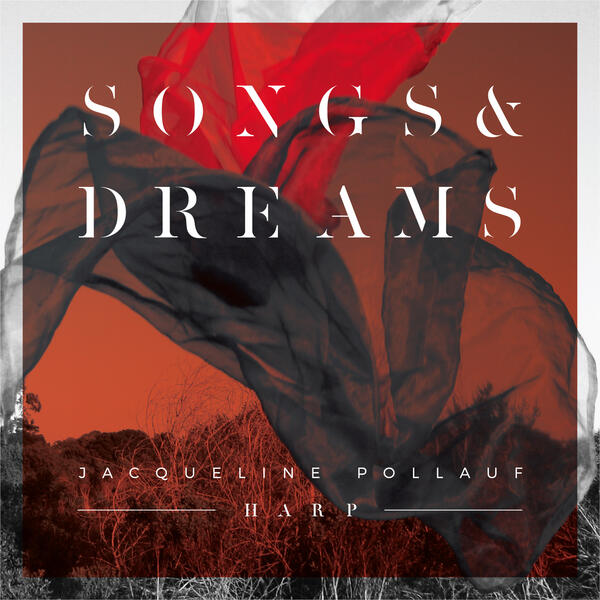 Album Cover of Songs and DreamsCover for Jacqueline Pollauf's 2018 solo album, Songs and Dreams. Design by Aleona Pollauf.
Album Cover of Songs and DreamsCover for Jacqueline Pollauf's 2018 solo album, Songs and Dreams. Design by Aleona Pollauf. -
Prelude no. 3 by George Gershwin, transcribed by Jacqueline PollaufPrelude no. 3 is from George Gershwin's (1898-1937) Three Preludes for piano. I love this piece and was determined to play it on the harp, despite some obvious difficulties. Gershwin includes all kinds of chromaticism, including quick chromatic scales in the interior line of two of the sections, which are fiendishly difficult for the harp.
-
Can't Help Falling in Love, Peretti, Creatore, and Weiss, arranged by Jacqueline PollaufThis was written by a three-person song writing team, Peretti, Creatore, and Weiss, and first recorded and made famous by Elvis Presley. I didn’t want to change anything about the beautiful and memorable melody, so instead the piece builds through an increasingly complex accompaniment.
-
Rose Red written and performed by Jacqueline PollaufRose Red is based on a haunting melody from the Elizabethan era. The melody is frequently sung as a round, which is echoed in this piece by the melody layering upon itself intricately. There are various lyrics that have been paired with the melody over the centuries. I chose to name the piece after the lyrics I know best: Rose, rose, rose red, Shall I ever see thee wed? I will marry at thy will sire, At thy will.
-
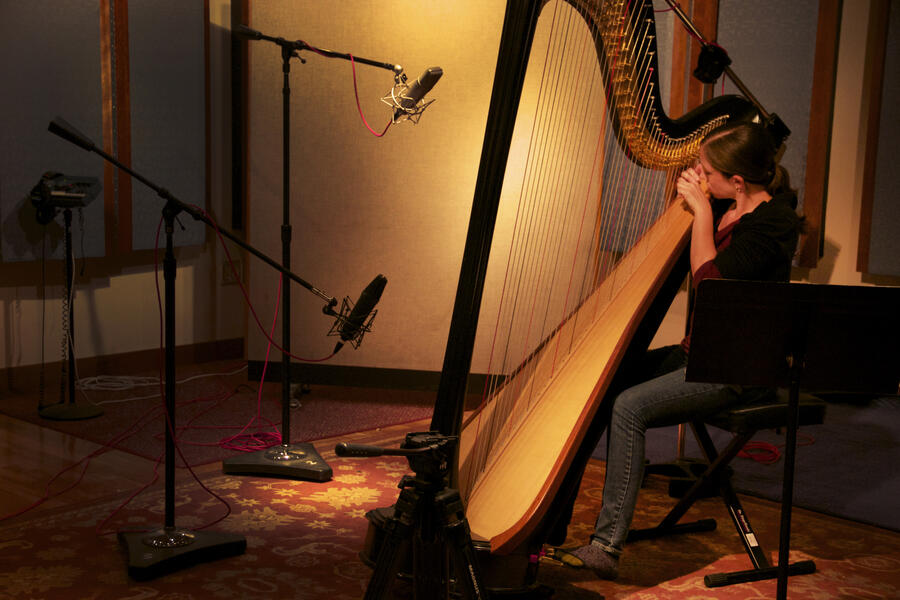 Recording SessionWorking on a studio recording.
Recording SessionWorking on a studio recording. -
Sunrise written and performed by Jacqueline PollaufSunrise is an intertwining of two songs, the well-known You Are My Sunshine, and Colours, written by the British singer/songwriter Donovan in the 1960’s. I was working on an arrangement of each piece separately, and somehow they ended up weaving their way together. For many of the transitions in the piece, the two melodies join seamlessly together. In the end, I came up with a title that melds lyrics from both pieces as well.
-
Liten Visa Till Karin by Staffan Linton, arranged by Jacqueline PollaufLiten Visa Till Karin (A Little Song for Karin) is based on a piece by Swedish jazz pianist Staffan Litton. I love to listen to jazz, and was drawn to the richness of Linton’s harmonies. This arrangement is certainly far removed from the original jazz chart, but hopefully in a way that blends the resonance of the harp with the core of Linton's work.
-
Prelude II by George Gershwin, trans. Jacqueline PollaufPrelude II by George Gershwin (1898-1937) comes from a set of three preludes for the piano. Also known as the Blue Lullaby, this slow prelude is quite chromatic, making for some challenging pedal changes.
-
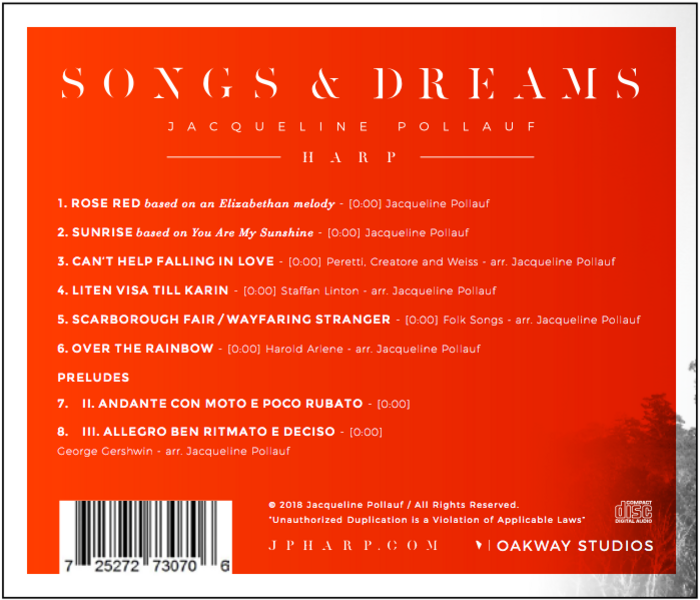 Songs and Dreams CD Back CoverThe back cover of the 2018 album Songs and Dreams
Songs and Dreams CD Back CoverThe back cover of the 2018 album Songs and Dreams
Trio Sirènes
I perform regularly with Trio Sirènes, alongside Marcia McHugh, flute and Karin Brown, viola. Claude Debussy (1862-1918) is generally considered the first composer to write for this instrumentation, but the English composer Arnold Bax (1883-1953), wrote a piece right around the same time. In this section, you can hear us play Bax's work, Elegiac Trio, along with a couple of contemporary pieces and a few transcriptions.
-
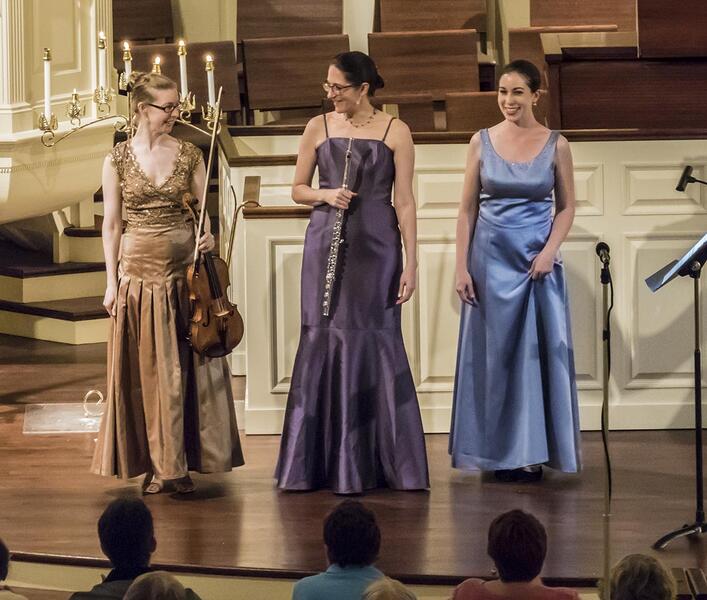 Trio Sirènes performance at Second Presbyterian ChurchTrio Sirènes (Marica McHugh, flute; Karin Brown, viola; and Jacqueline Pollauf, harp) perform at Second Presbyterian Church, Baltimore, Maryland. Photo by Lawrence Siegel.
Trio Sirènes performance at Second Presbyterian ChurchTrio Sirènes (Marica McHugh, flute; Karin Brown, viola; and Jacqueline Pollauf, harp) perform at Second Presbyterian Church, Baltimore, Maryland. Photo by Lawrence Siegel. -
Elegiac Trio by Arnold BaxTrio Sirènes (Marcia McHugh, flute; Karin Brown, viola; and Jacqueline Pollauf, harp) performs Elegiac Trio, by Arnold Bax (1883-1953). Although certainly an impressionistic piece with its sweeping lines and the many colors Bax explores, it is written, surprisingly, in a simple 4/4 meter. Each instrument is featured virtuosically throughout the piece. The harp begins and ends the work, and also introduces a contrasting middle section.
-
Three Shades Without Angles by Hannah LashTrio Sirènes (Marcia McHugh, flute; Karin Brown, viola; and Jacqueline Pollauf, harp) performs Hannah Lash's (b. 1981) Three Shades Without Angles, composed in 2014. The piece alternates between relentless driving sections and quieter spacious sections. Lash's primary instrument is the harp, and she uses the instrument fully, including a section in the middle of the piece where arpeggios start on the lowest string of the harp, climb to the top string and return continuously, making the piece both physically and musically demanding to play.
-
Sonatine by Maurice Ravel, trans. Skaila KangaTrio Sirènes (Marcia McHugh, flute; Karin Brown, viola; and Jacqueline Pollauf, harp) performs Sonatine by Maurice Ravel (1875-1937). It was originally written for solo piano and here is transcribed for flute, viola and harp by English harpist Skaila Kanga (b. 1946). This is the complete piece, with movements as follows: I. Modéré II. Mouvement de Menuet III. Animé
-
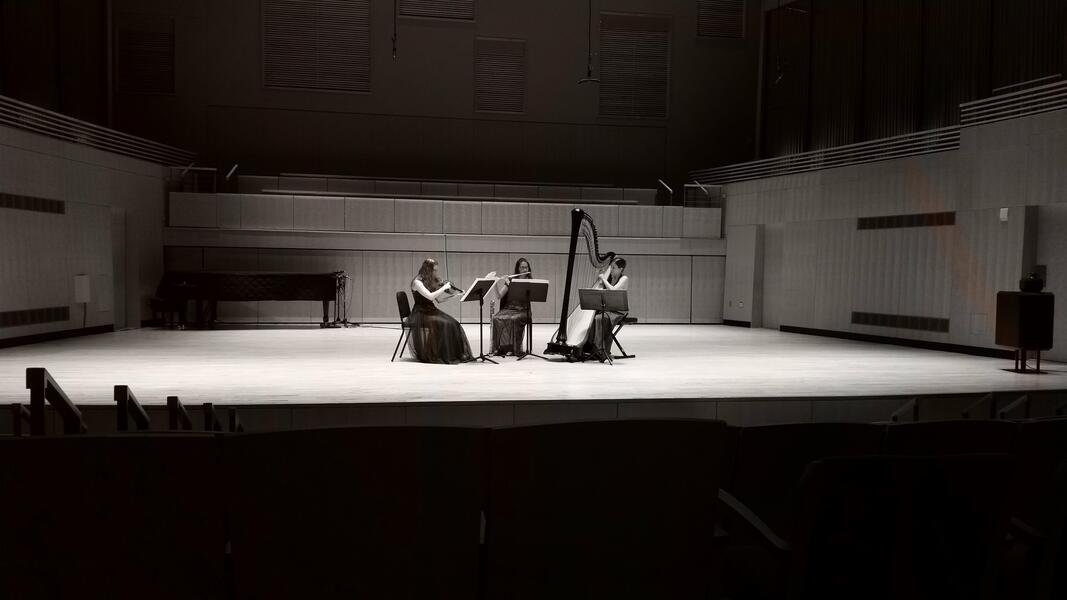 Trio Sirènes performance at UMBCTrio Sirènes (Marica McHugh, flute; Karin Brown, viola; and Jacqueline Pollauf, harp) perform at the University of Maryland, Baltimore County, Baltimore, Maryland.
Trio Sirènes performance at UMBCTrio Sirènes (Marica McHugh, flute; Karin Brown, viola; and Jacqueline Pollauf, harp) perform at the University of Maryland, Baltimore County, Baltimore, Maryland. -
Prelude and Fugue in c minor, BWV 871, J. S. Bach, arr. Rudolf KämperTrio Sirènes (Marcia McHugh, flute; Karin Brown, viola; and Jacqueline Pollauf, harp) perform J. S. Bach's (1685-1750) Prelude and Fugue in c minor, BWV 871. This is from the second book of Bach's monumental work, The Well-Tempered Clavier. Rudolf Kämper (b. 1976) arranged the work for Trio Sirènes. As the work was originally for solo keyboard, he not only divided the part up between the instruments, but also expanded upon it, in some instances using harmonies that are decidedly of the 21st century.
-
Et Descendit by Sungji HongTrio Sirènes (Marcia McHugh, flute; Karin Brown, viola; and Jacqueline Pollauf, harp) perform Sungji Hong's (b. 1973) work, Et Descendit. Hong composed this work in 2015 and since then Trio Sirènes has championed it, giving it many performances at a variety of venues. The work is a subtle exploration of colors and timbres between the three instruments.













